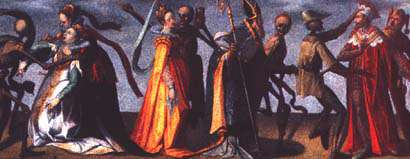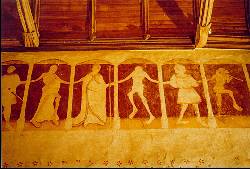 |

|
|
Copyright (textes) |
The artistic genre of the dance of death was most probably developed in France. The dance of death of the Cimetière des Innocents in Paris, painted in 1424, is considered the starting point of this tradition. (That work having been destroyed, we know it only through a reproduction in a book published into 1485 by the editor Guyot Marchant.) Afterwards were created among others the frescoes of London (circa 1430), of Basel (a first one around 1440 and a second around 1480), of La Chaise-Dieu (circa 1460-70), of Lübeck(1463). During the second half of the 15th century, the dance of death enjoyed an always growing popularity. You can now admire several dances of death on this site. Some are painted al fresco, like the one in France, Germany, Italy or from various countries. Others come from manuscripts or books, some are works by famous artists like Hans Holbein the Younger, Daniel Nikolaus Chodowiecki or Johann Elias Ridinger and some other are the works of unknown artists. The dances od death were mostly painted (or more rarely carved) on the outside walls of cloisters, of family vaults, of ossuaries or inside some churches. These frescoes represent an emaciated corpse or a skeleton coupled with a representative of a certain social class. The number of characters and the composition of the dance vary. The dance of death often takes the form of a farandole. Below or above the picture are painted verses by which death adresses its victim. He often talks in a threatening and accusing tone, sometimes also cynic and sarcastic. Then comes the argument of the Man, full of remorse and despair, crying for mercy. But death leads everyone into the dance: from the whole clerical hierarchy (pope, cardinals, bishops, abbots, canons, priests), to every single representative of the laic world (emperors, kings, dukes, counts, knights, doctors, merchants, usurers, robbers, peasants, and even innocent children). Death does not care for the social position, nor for the richness, sex, or age of the people it leads into its dance. It is often represented with a musical instrument. This characteristic has a symbolic significance and appears already at the beginning of the dance of death. The instrument evokes the tempting, a little diabolic enchanting power of music. Think of the sirens' song, of the flute player of Hameln, etc. Like them, death charms mankind with its music.
Before the first dance of death was created, there was a literary genre called Vado Mori (I prepare myself to die): poem written in Latin, of French origin, which went back to the 13th century. In these writings, representatives of various social classes complain, mostly in two verses, about the fact that they will soon have to die. In the oldest texts of that kind, there was a prologue underlining the certainty of death and, following this prologue, the last verses of eleven dying men (the king, the pope, the bishop, the knight, the physicist, the logician, the young man, the old man, the rich, the poor and the insane). In the most recent versions, the prologue was abolished and the number of characters increased significantly. The Vado Mori and the dance of death thus share some characteristics: the lament of a dying man, characters representing their social class, and a clear separation between the laic people and the clerks. However, death does not appear in the Vado Mori and nobody answers the laments of the dying ones. Consequently, the Vado Mori cannot be considered as a direct ancestor of the dance of death, nor the medieval superstitions, and nor either the mysteries, medieval theatre plays with religious theme. The origin of the dance of death is still unknown, although there are many theories about it. A thing is sure: the term "danse macabre" was known and used before 1424 (i.e.even before the creation of the dance of death in Paris). In his poem entitled Respit de la Mort, Jean Lefevre writes: Je fis de Macabre la danse, It is not farfetchedness to think that this poet had just escaped death when he wrote that. He could have been recovering from a serious disease.
In the Middle-Ages, the dance of death was though as a warning for powerful men, a comfort to the poor, and ultimately an invitation to lead a responsible and christian life. But its basic idea is even more simpler, more timeless: to recall the shortness of life. It makes men remember that they all will die, without exception. It is also not astonishing that every century since the Middle-Ages has had its own dances of death. Chronological list of the dances of death The list that follows is a non-exhaustive enumeration of the dances of death that are known. Those you can see on this site have a link. France
|

